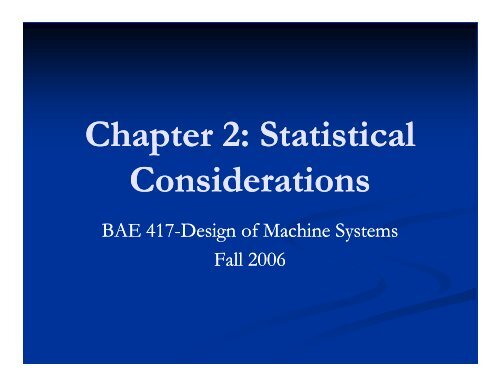Chapter 2: Statistical Considerations
Chapter 2: Statistical Considerations
Chapter 2: Statistical Considerations
You also want an ePaper? Increase the reach of your titles
YUMPU automatically turns print PDFs into web optimized ePapers that Google loves.
<strong>Chapter</strong> 2: <strong>Statistical</strong><br />
<strong>Considerations</strong><br />
BAE 417 417-Design Design of Machine Systems<br />
Fall 2006
Limits, Fits, and Tolerances<br />
(Sections 22-6<br />
6 and 2-7) 2 7)<br />
Capital letters refer to holes; lowercase letters are used for shafts
Limits and Fits<br />
Basic Size Size- size to which limits or deviations are<br />
assigned<br />
Deviation Deviation- algebraic difference between size and<br />
corresponding basic size<br />
Upper deviation deviation- indicates maximum difference<br />
Lower deviation deviation- indicates minimum difference<br />
Fundamental deviation deviation- which of the above is closer<br />
to the basic size
Limits and Fits<br />
Tolerance Tolerance- difference between max. and min.<br />
size limits<br />
International tolerance grade numbers (IT)-<br />
designated groups of tolerances that vary<br />
depending on basic size<br />
Hole basis basis- system of fits corresponding to hole<br />
sizes (H is the fundamental deviation)<br />
Shaft basis basis- system of fits corresponding to shaft<br />
size (h is the fundamental deviation)<br />
See Table 22-8<br />
8 for a Description of Preferred Fits Using the Basic Hole System
Conventions and Variable<br />
Definitions<br />
D- basic hole size<br />
d- basic shaft size<br />
δ- deviation<br />
δ δu-- upper deviation<br />
δl- lower deviation<br />
δF- fundamental deviation<br />
ΔD- tolerance grade for hole<br />
Δd- tolerance grade for shaft
For holes<br />
D max = D + ΔD D (Eq. 22-38)<br />
38)<br />
D min = D<br />
For shafts with clearance fits c, d, f, g, and h<br />
d max = d + δ F (Eq. 22-39)<br />
39)<br />
d min = d + δF – Δd<br />
For shafts with interference fits k, n, p, s, and u<br />
d min = d + δ F (Eq. 22-40)<br />
40)<br />
d max = d + δF + Δd
Example<br />
Find the shaft and hole dimensions for a loose<br />
running fit with a 34 34-mm mm basic size.
Solution<br />
From Table 22-8<br />
8 we find the ISO symbol to be<br />
34H11/c11<br />
From Table AA-11<br />
11 using the IT tolerance grade<br />
of 11 (IT11) and a basic size of 34 (34 mm) we<br />
get ΔD D = Δd= d= 0.160 mm<br />
Using Eq. 22-38<br />
38 we get:<br />
D max = D + ΔD D = 34 + 0.160 = 34.160 mm<br />
D min = 0.160 mm
Solution<br />
Using Table AA-12<br />
12 we find the fundamental<br />
deviation ( (δF) ) for the 34c11 shaft to be<br />
δF= = -0.120 0.120 mm<br />
Using Eq. (2 (2-39) (2 (2-39) 39) we get:<br />
d max = d + δF = 34 – 0.120 = 33.880 mm<br />
d min = d + δF – Δd d = 34 - 0.120 – 0.160 = 33.720 mm
Dimensions and Tolerances<br />
Nominal size - size for speaking of an element (i.e., ½”<br />
bolt or 3” pipe)<br />
Basic size – exact theoretical size<br />
Limits – stated maximum and minimum dimensions<br />
Tolerance – difference between two limits<br />
Bilateral – 1.005 ± 0.002 in<br />
+ 0.<br />
004<br />
Unilateral – 1.<br />
005 in<br />
−0.<br />
000<br />
Natural tolerance – plus and minus three standard<br />
deviations
Dimensions and Tolerances<br />
Clearance – difference in dimensions (diametral<br />
or radial)<br />
Used only when the internal member is smaller than<br />
the external member<br />
difference in dimensions<br />
Used when the internal member is larger than the<br />
external member<br />
Interference – difference in dimensions<br />
Allowance – minimum clearance or maximum<br />
interference
Tolerance Stacking<br />
The “gap”, “grip”, or “interference” of an assembly of mating parts is<br />
defined as:<br />
w<br />
= ∑ x −∑<br />
y i j<br />
where x’s are right tending and y’s are left tending displacements
Homework Assignment<br />
Do problems 22-25,<br />
25, 2-27, 2 27, and 2-32 2 32 for next<br />
Tuesday.


